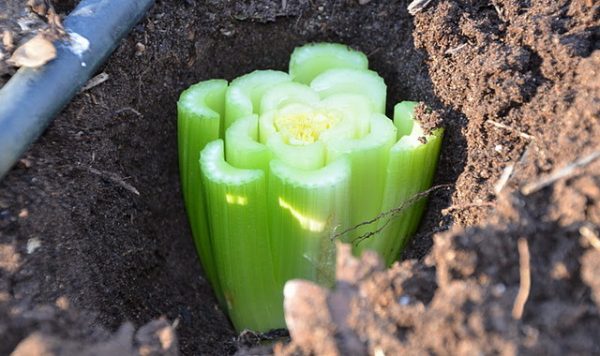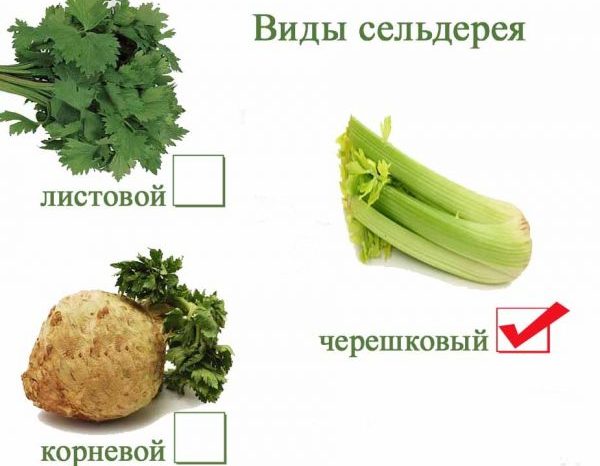Celery stalk: growing and care in the open field
Content
Germination of stalked celery seeds
Before planting celery seeds, you should take into account its feature of poor and long germination. After dry sowing, the first shoots may appear no earlier than a month and will grow out of order. There are a lot of gardeners who soak the seeds for several days at home before sowing, while changing the water several times daily. Due to the excess of the essential oil of the seeds, slow germination occurs, which can be accelerated with warm water at about + 60C. After the water cools down, the oil rises to the surface of the water and then the seeds should be rinsed with running water.
After washing, they should be laid out on damp paper or cotton cloth on a plate, and packed in a bag for the greenhouse effect at home. To enhance this effect, the plate can be placed in a warm, dark place, but remember to ventilate it and dampen the cloth or paper. There is another method of germinating seeds for seedlings at home. You need to take a jar, preferably a glass one, and send sawdust there. After moistening the sawdust well, you can lay out the seeds mixed with sand. An unopened jar is placed in a warm and lighted place until germination, constantly adhering to regular watering and room temperature + 25C.
Video "Instruction for growing"
A detailed video instruction on the cultivation of the stalked type of celery.
Preparing the soil for planting
The soil for planting celery seedlings is prepared in advance before sowing. Since the seedlings are planted from late February to early March. If you prepare the soil yourself, then you will have to stock up on peat, humus and wood ash. The proportions of the mixture are 3/5 peat, 1/5 humus, 1/5 ash and a little sand. If you do not have these ingredients for preparing soil for seedlings, then such a mixture can be bought ready-made in a specialized store. In this case, an earthen mixture is suitable, which is also suitable for growing onions and other vegetables.
In pre-prepared pots or boxes for growing seedlings, the prepared or purchased mixture of earth is poured and poured with water. Seeds that have sprouted are carefully planted in shallow grooves without disturbing or breaking off their weak roots. It is not necessary to sprinkle them with earth, you can just press a little, but no deeper than half a centimeter, otherwise it will be difficult for them to grow. You can also grow celery seeds using the snow method. The processes are almost the same only instead of daily watering the earth, the box is covered with a layer of snow, on which the seeds are spread. When the snow melts, it will give the necessary moisture and deepen them to the required depth into the ground.
Seedling care
Home care for already grown seedlings will not be difficult.The earth should not dry out, but the water should not stand in the box either; spraying from a spray bottle is the best option. Within a few weeks it will be possible to make the first plant feeding. Densely grown seedlings should be thinned and dived when 3-4 leaves appear. The seedlings should be deepened by half the stem into the ground.
After picking, after two weeks, it is worth feeding the plants again. But a week before planting in the country in the open ground, celery should be hardened at a temperature of + 15C. To maintain this temperature, you can take the container out to a well-lit balcony. When the very moment of planting comes, it is imperative to water the plants.
Landing in open ground
You can start planting celery seedlings from mid-May. There should be at least 15-20 centimeters between plants, and the rows between themselves should be no closer than 30-40 centimeters. After planting, water and sprinkle with earth. The care includes feeding, weeding, loosening, watering and fighting diseases. Petiole celery needs regular feeding and care after planting in the soil.
When exactly a month has passed since the planting of seedlings in the soil, the first feeding is carried out, the second with a very active growth of greenery, the third with increased root growth. For top dressing, 10 g of ammonium nitrate, 30-40 g of superphosphate and 20-30 g of potassium sulfate per 1 m2 are used. Beware of the development of not petioles in celery, but a root, part of the earth is removed from its upper part and the lateral shoots of the root are pinched. The procedure should be repeated three to four times until the root crop is formed. Mulching around the plant will be an additional care; watering should be moderate, depending on the weather conditions.
Do not let the earth dry out or stagnate water in the grooves of the garden beds. Hilling for stalked celery is the most important thing in caring for it. It is carried out with the beginning of intensive growth and thickening of the petioles. Repeat the procedure if necessary to care for the plants. This will help to get bleached stalks without bitterness on the inside and delicate taste. But there is another method of care for obtaining delicate pulp.
A couple of weeks before harvesting, the celery is tied at the top of the petiole and wrapped with paper. The harvest is fully harvested before the first frost. On cold September nights with temperatures below -5 C, it is worth covering the celery with acrylic material. Despite all this, there are still difficulties in growing celery.
A sufficient amount of water in a vegetable may not externally manifest this in any way, but its stalks simply cannot be eaten. Try to water the plant as often as possible, otherwise all the work and care may be in vain. The plant is not spared from the simplest shooting, it is a signal of drying out of the soil or untimely planting of seedlings in the country. Wherever there is good humidity, snails and various slugs can appear. To save the plant, weeds in the garden should be weeded out in time.
The decay of the middle proceeds imperceptibly and the problem can be realized only by harvesting. This is due to putrefactive bacteria, which were formed as a result of stagnation of water in the ground. When the soil is too dry or too much nitrogen in it, the stalks crack.
How to harvest and store crops
Depending on the ripening of the vegetable, the harvesting of the grown crop begins, depending on the climate, but presumably from August and may last until the first frost. Storage is no different from other root crops growing in the country. Petioles are cut from August, and its leaves are cut as needed. The crop can be stored dried or frozen.
Video "Practical Tips"
An informative video with helpful practical tips for gardeners.





